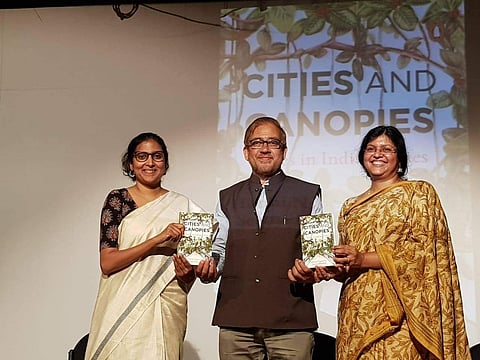

All of us learn about the environment, nature and saving trees in our school days. But how many of us know about which trees are native and which ones were introduced in India by other countries, or the connection between trees and religious scriptures. If you really want to know more about this, then Harini Nagendra and Seema Mundoli's book Cities and Canopies: Trees in Indian Cities is a must read. Two years of research about the trees in India have transformed been written in the form of stories to make it easy for the common man to understand. In addition to this, the book has been made interesting with different sketches by botanical illustrator Alisha Dutt Islam, so that children can also read it.
Harini and Seema, who work at Azim Premji University, have co-authored several research papers on sustainability, biodiversity, urban forestry, ecosystem management and much more. The duo has found each other's work interesting and satisfying. Hence, In 2017, they came across this idea of writing a book on trees in India. Harini says, "Earlier, I wrote a book titled Nature in the City: Bengaluru in the Past, Present and Future which is more focussed on research and ecology. I also received positive responses from people for this book. Originally, our idea was to write a book only on the trees in Bengaluru. But trees are spread everywhere and common man ought to know about the trees and canopies that exists in India. Apart from bringing down the pollution level, trees serve as a lifeline to many people. They give us shade, fruits and some are even related to the mythological stories."
The duo started writing the book in March 2018 and completed it by September. Seema says, "Though we hit upon the idea of writing this book in 2017, our research was on since 2014. In order to get the right information about trees and canopies, we have been visiting various libraries that have archives in Bengaluru, Mysore, Chennai, The British Library in London, Forest Research Institute in Dehradun and other places. Every time we visited these places outside Bengaluru, we picked up anything related to nature which we also found interesting."
This is how some of the better anecdotes came to be, "When we researched about silk cotton, we were able to find out that the name was mentioned in a historical document in the 1800s. Similarly, we have included some old memories that we had about trees during our childhood. Last year, when I visited Sabarmati Ashram, I came across a distinctive neem tree and then I remembered reading how Mahatma Gandhi was partial towards the neem tree due to its medicinal benefits. In fact, he had asked a person called Totaram Sanadhya to plant this tree. Hence we added all this information when we wrote about the neem tree."
Some interesting chapters
The book has an interesting chapter on native and exotic trees which deal with a kind of identity crisis. For example, trees like tamarind and coconut are found in many Indian cities but it is not necessary that they are originally from India. In fact coconut trees were brought from Malaysia and tamarind, from Africa. Having spent their childhood among trees and greenery, they thought it was important to include a chapter on their own experiences. A chapter titled Fun With Trees in Art and Play is based on their childhood days where Harini would collect varieties of flowers from the garden and her mother would ask her to find out why a particular flower has five petals, why some have six petals and why some flowers come in a cluster. Harini says, "That's how nature inspired us. This is what led us to develop thinking and reasoning power."
Some of the India's most sacred trees
When Seema visited Dehradun for her archival work, she heard about the peepal tree planted by Sarojini Naidu near the iconic Clock Tower, in the 1940s. She noticed that it was very huge and a campaign was going on to stop officials from cutting it down. Seema goes on narrating many such stories about some of the oldest trees in India. She says, "There is a tamarind tree in Afzal Park in Hyderabad. Once there was a huge flood called Musi in 1908 and people climbed up this tree to save their lives. Hence, every year, many people in Hyderabad gather around this tree to commemorate the day when floods occurred."
The neem tree in Ujjaini Mahakali Temple in Hyderabad dates back to 1813 also find its place in this book. It says that Suriti Appaiah from Hyderabad who carried medical stretchers in the medical unit of the British Army was posted in Ujjain. When he heard about the cholera epidemic, he had prayed in the Sri Ujjaini Mahakali temple that if the epidemic is controlled then he would install the idol of this goddess in Hyderabad. On returning in 1815, he installed a wooden idol and planted a neem tree alongside.
Show me the money
Seema and Harini have been researching on sustainability and urban development and most of the funding comes from the research centre in Azim Premji University. Seema says, "Urban Sustainability is one of the topics that the university focuses on. They wanted us to write about the challenges in the future for sustainability in urban areas like Bengaluru. It is definitely a huge area which requires deep research and attention. This book is also supported by the University."
When we asked Seema what plants or trees are good to grow in India, "All trees including banyan, ficus, peepal, pongamia, tamarind are good to be grown in India. But one should be careful of the space where they should be planted. These are huge trees and one cannot plant them in narrow roads or footpaths. They need to be planted in a slightly bigger space so that their roots can spread deeper and wider."
